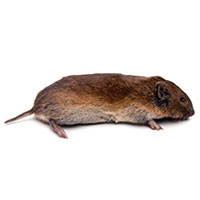Secure Your Lawn: Efficient Vole Control Techniques
Secure Your Lawn: Efficient Vole Control Techniques
Blog Article
Understanding Vole Parasite Control: Extensive Insights on Invasion Avoidance and Therapy Techniques
By identifying the subtle indications of vole infestation early on, we can take proactive measures to avoid widespread damages. In this discussion, we will check out the subtleties of vole habits, dig into the identification of infestation indicators, and uncover the most efficient avoidance and treatment approaches.
Understanding Vole Actions
Analyzing the foraging patterns of voles offers useful understandings into their actions and environment preferences. By observing their foraging behavior, scientists can get a much better understanding of where voles like to establish their habitats and the degree of their ecological impact.
Research study shows that voles display selective feeding habits, liking roots, seeds, and roots. This nutritional preference affects their foraging patterns, leading them to areas abundant in vegetation and ground cover. Furthermore, voles are recognized to create sophisticated tunnel systems for foraging and nesting objectives, showing a high degree of adaptability to their environments.
Comprehending vole behavior is essential for implementing targeted parasite control steps that interrupt their habitat choices and foraging tasks (vole yard damage). By studying their habits, professionals can create much more effective prevention and treatment methods to take care of vole infestations

Identifying Signs of Vole Invasion
Vole infestations can be found by acknowledging details signs of their presence in an area. One of the most usual signs of a vole infestation is the presence of surface area runways.
An additional vital sign of vole invasion is the visibility of small burrow openings in the ground. Voles dig shallow burrow systems with numerous entryways and exits. These burrows function as shelter and nesting websites for the voles. In addition, voles are known to leave eaten plant stems, roots, and light bulbs near their burrow openings, suggesting their feeding task in the location.
Additionally, vole droppings can likewise represent their existence. Vole droppings are little, brown, and cylindrical fit, looking like grains of rice. Discovering these droppings along runways or near burrow openings can verify a vole infestation. By being alert for these indicators, residential or commercial property owners can quickly attend to vole infestations and avoid more damage.
Carrying Out Positive Prevention Procedures

Additionally, utilizing natural vole deterrents like castor oil-based repellents or killer pee can function as efficient preventative actions. It is also advisable to frequently inspect exterior rooms for any type of indications of vole activity, such as runways or burrow openings, to deal with prospective invasions quickly. vole pest control. By embracing these positive avoidance techniques, homeowner can substantially lower the likelihood of vole damages and keep the health and wellness and visual appeals of their landscapes
Efficient Therapy Approaches
Including targeted trapping methods and using authorized rodenticides are necessary components of efficient treatment approaches for taking care of vole problems. Capturing can be a reliable way to minimize vole populaces, specifically when placed strategically in their active runways. Snap traps and live traps can both work, with the last permitting the capture and relocation of voles. When making use of rodenticides, it is essential to Clicking Here adhere to safety guidelines to avoid injury to non-target animals and pets. Area rodenticides in safe bait terminals to reduce threats to unintended targets. In addition, habitat modification, such as minimizing ground cover and eliminating resources of food, can assist discourage voles from infesting an area. Normal monitoring and upkeep are additionally essential elements of effective therapy approaches to make sure next that vole populations are maintained under control. By combining capturing, rodenticides, habitat modification, and consistent surveillance, reliable vole bug control can be achieved.
Surveillance and Upkeep Tips
Normal surveillance enables for the very early detection of vole task, allowing punctual intervention prior to invasions aggravate. To effectively monitor vole populations, strategically placed catches can be used in vole paths or near burrow entrances.
In addition, keeping a neat and well-kept landscape is essential in vole avoidance. Clearing away particles, such as heaps of wood or dense plants, gets rid of prospective vole environments. Routinely trimming and cutting grass plant life aids reduce vole hiding places and minimizes their access to food sources.
Additionally, continuous maintenance of physical barriers, such as fences or cable mesh, is crucial to avoid vole invasion. Examining and repairing any problems to these structures makes certain that vole control continues to be reliable in safeguarding residential or commercial properties from infestations. By integrating these monitoring and maintenance techniques into a comprehensive vole pest control strategy, individuals can effectively manage vole populations and protect their properties from damages.
Final Thought
In conclusion, mastering vole bug control needs a solid useful content understanding of vole behavior, the ability to recognize indications of invasion, executing aggressive avoidance steps, efficient treatment methods, and constant tracking and upkeep. By taking a comprehensive method to vole control, people can effectively handle and protect against invasions, inevitably shielding their residential or commercial property and bordering atmosphere from damage triggered by these small rodents.
In this discussion, we will explore the nuances of vole habits, delve into the identification of problem signs, and discover the most reliable prevention and therapy approaches.Including targeted trapping techniques and making use of authorized rodenticides are essential parts of reliable treatment techniques for handling vole invasions. To effectively keep track of vole populaces, tactically put traps can be made use of in vole paths or near burrow entrances. Examining and fixing any type of damages to these structures makes sure that vole control stays effective in securing residential or commercial properties from invasions. By including these monitoring and upkeep methods right into a detailed vole insect control plan, people can efficiently take care of vole populations and secure their residential properties from damages.
Report this page